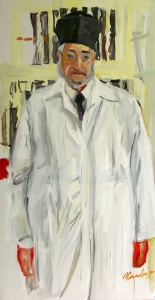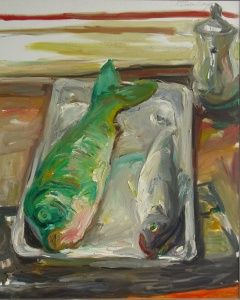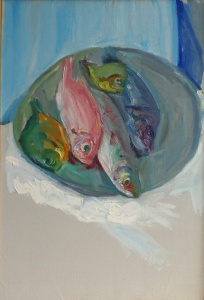Eisenberg’s Space
Space is created in the visual arts in a multitude of ways. Illusionistic space was invented in the Renaissance and continues to be depicted in contemporary realism. This method creates the impression of looking through a window and seeing an ordered progression of objects, those closest the largest and diminishing in size as distance increases, all converging on one or more points on the horizon.
A unified system of perspective is imposed on all visual experience. Atmospheric perspective is a similar system that substitutes contrasts of light and dark, and intensity of colors to create the feeling of depth. Then there is Modernist space of abstract juxtaposition that celebrates the physical surface of the painting, admitting the simple fact that all depictions of space are illusions since the painting or drawing is in fact only two dimensional. Finally there is a specific kind of Modernist space that does not deny the possibility of illusion and yet still celebrates the joys of the painting’s surface. It is a space that is simultaneously present and absent, conjured by enthusiastic paint handling and the more than occasional bare canvas. This is Raphael Eisenberg’s space.

In Eisenberg’s portrait of Benzion Miller a shallow personalized space is depicted. The famous cantor is standing in front of a series of dark verticals that seem to support him and his formal cantor’s hat. We might suppose that this grid is a bookcase of seforim but Eisenberg gives us no hint of specifics. Rather the shapes operate as an abstract design contrasted with the volumetric rendering of Benzion’s kittel-clad body to help create a measured distance between them. The space is made in this painting by these contrasts and repeats of the red of his hands and a red object behind him, causing the eye to jump between the points, thereby creating depth. The ample use of bare canvas insists that whatever we think we see is actually but a painted illusion.
The current exhibition of Eisenberg’s works at the Chassidic Art Institute (December 25-January 25, 2006) is a casually defined retrospective of his work over the last twenty years. It ranges from his well known portraits of Borough Park (first exhibited in 2002 at the Brooklyn College Art Gallery), Rebbi paintings, Israeli landscapes, cityscapes and, most intriguingly, fish paintings.
Fish have been a favorite subject for artists since Romans immortalized our watery friends in mosaic floor decoration. During the Renaissance there was a hiatus of paintings of fish but they returned in full splendor in the great still lifes of the eighteenth century French master, Jean-Baptiste Simeon Chardin. The twentieth century saw the French Jewish artist Chaim Soutine continue this tradition with expressionistic works of still lifes utilizing fish. One notable painting pays homage to Chardin in his painting of The Sting Ray. Most of this genre of still life uses dead fish as a kind of veritas (Latin for Truth), commenting on the fragility of life and visceral nature of death. Eisenberg’s fish are firmly in this tradition.

The humorously titled Bedfellows is a brilliant case in point; the creation of a resolutely mundane space that still demands our attention to the larger meaning of things, notably the fleeting nature of our existence. His depiction of two kinds of fish seen from above, one a slick green and the other silvery white and gray, sets them in a dialogue with each other, the shallow aerial space giving us an illusion of control. Ostensibly facing they cause us to ponder why the left one’s eyes are glazed over while the smaller fish on the right with a red gash for a mouth is staring at the viewer. Accusation, hostility or simply death? The plot thickens as we are informed by the artist that one is kosher and the other non-kosher and poisonous. Life is indeed complex.

The same use of space is utilized in Five on a Plate, but here with a more vertiginous effect. As opposed to Bedfellows, centered, weighted and within the viewer’s control, this depiction balances the plate and its slippery occupants in the upper third of the painting precariously hanging over the back edge of a table. Even more upsetting is the vast amount of blank canvas below the plate’s immediate proximity, creating the feeling that it could easily slip off and crash to the floor at our feet any moment. Three of the five fish stare open eyed from the cool confines of death causing a disquieting unease in the otherwise cheerfully colored painting.
This exhibition raises a number of issues with Eisenberg’s paintings. His creation of space is modern, shallow and does not allow us much elbow room, limiting the symbolic freedom of motion found in illusionist space. By his own admission, there is little or no specifically Judaic content in most of these works, in fact he denies there is any art that could be defined as Jewish art. Rather for him “painting is a reflection of how an artist perceives the world that is in front of him, not as a camera, but rather as a heart and a brain.” A thoroughly modernist statement if there ever was one.
Nonetheless the issue of the creation of pictorial space continues to nag at our consciousness. Renaissance space, illusionistic and confident in an ordered universe with man (and his perceptions) firmly at its center, cannot express fundamental Jewish values that revel in the complexity of divine and human relationships. But is it possible that there is a kind of space that is Jewish, meaning that Jewish values and sensibilities are expressed therein? I don’t know but it seems clear to me there are some depictions of space that can’t be Jewish. And if that is the case, surely the space Eisenberg creates might fit the bill as a potential Jewish space. Complex, uncertain, nervous and tentative, ultimately expressing the heart and a brain of a Jew. After all, if we can’t have a kind of art named after us, the least we could have is a little bit of space of our own.